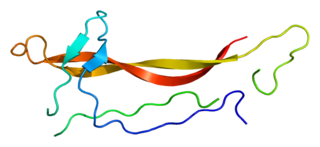
The vomeronasal organ (VNO), or Jacobson's organ, is the paired auxiliary olfactory (smell) sense organ located in the soft tissue of the nasal septum, in the nasal cavity just above the roof of the mouth in various tetrapods. The name is derived from the fact that it lies adjacent to the unpaired vomer bone in the nasal septum. It is present and functional in all snakes and lizards, and in many mammals, including cats, dogs, cattle, pigs, and some primates. Some humans may have physical remnants of a VNO, but it is vestigial and non-functional.

Neurotrophin-3 is a protein that in humans is encoded by the NTF3 gene.
Odorant-binding proteins (OBPs) are small soluble proteins secreted by auxiliary cells surrounding olfactory receptor neurons, including the nasal mucus of many vertebrate species and in the sensillar lymph of chemosensory sensilla of insects. OBPs are characterized by a specific protein domain that comprises six α-helices joined by three disulfide bonds. Although the function of the OBPs as a whole is not well established, it is believed that they act as odorant transporters, delivering the odorant molecules to olfactory receptors in the cell membrane of sensory neurons.

Neuropilin 2 (NRP2) is a protein that in humans is encoded by the NRP2 gene.

Taste receptor type 2 member 1 (TAS2R1/T2R1) is a protein that in humans is encoded by the TAS2R1 gene. It belongs to the G protein-coupled receptor (GPCR) family and is related to class A-like GPCRs, they contain 7 transmembrane helix bundles and short N-terminus loop. Furthermore, TAS2R1 is member of the 25 known human bitter taste receptors, which enable the perception of bitter taste in the mouth cavity. Increasing evidence indicates a functional role of TAS2Rs in extra-oral tissues.

Taste receptor type 2 member 3 is a protein that in humans is encoded by the TAS2R3 gene.

Taste receptor type 2 member 4 is a protein that in humans is encoded by the TAS2R4 gene.

Taste receptor type 2 member 8 is a protein that in humans is encoded by the TAS2R8 gene.

Taste receptor type 2 member 9 is a protein that in humans is encoded by the TAS2R9 gene.

Taste receptor type 2 member 13 is a protein that in humans is encoded by the TAS2R13 gene.

Taste receptor type 2 member 7 is a protein that in humans is encoded by the TAS2R7 gene.

Homer protein homolog 3 is a protein that in humans is encoded by the HOMER3 gene.
DAMGO is a synthetic opioid peptide with high μ-opioid receptor specificity. It was synthesized as a biologically stable analog of δ-opioid receptor-preferring endogenous opioids, leu- and met-enkephalin. Structures of DAMGO bound to the µ opioid receptor reveal a very similar binding pose to morphinans.

Vomeronasal receptors are a class of olfactory receptors that putatively function as receptors for pheromones. Pheromones have evolved in all animal phyla, to signal sex and dominance status, and are responsible for stereotypical social and sexual behaviour among members of the same species. In mammals, these chemical signals are believed to be detected primarily by the vomeronasal organ (VNO), a chemosensory organ located at the base of the nasal septum.
Slit-Robo is the name of a cell signaling protein complex with many diverse functions including axon guidance and angiogenesis.
John R. Carlson is an American biologist and professor. He currently holds the Eugene Higgins Professor of Molecular, Cellular, and Developmental Biology at Yale University.
Christopher A. Walsh is the Bullard Professor of Neurology at Harvard Medical School, Chief of the Division of Genetics at Children's Hospital Boston, Investigator of the Howard Hughes Medical Institute, and the former Director of the Harvard-MIT MD-PhD Program. His research focuses on genetics of human cortical development and somatic mutations contributions to human brain diseases.
Kimberly W. Anderson is an American chemist. She is the Gill Eminent Professor of Chemical Engineering and Associate Dean for Administration and Academic Affairs in the College of Engineering at the University of Kentucky.
Dragana Rogulja is a Serbian neuroscientist and circadian biologist who is an assistant professor in Neurobiology within the Harvard Medical School Blavatnik Institute of Neurobiology. Rogulja explores the molecular mechanisms governing sleep in Drosophila as well as probing how circadian mechanisms integrate sensory information to drive behavior. Rogulja uses mating behavior in Drosophila to explore the neural circuits linking internal states to motivated behaviors.
Lauren Orefice is an American neuroscientist and assistant professor in the Department of Molecular Biology at Massachusetts General Hospital and in the Department of Genetics at Harvard Medical School. Orefice has made innovative discoveries about the role of peripheral nerves and sensory hypersensitivity in the development of Autism-like behaviors. Her research now focuses on exploring the basic biology of somatosensory neural circuits for both touch and gastrointestinal function in order to shed light on how peripheral sensation impacts brain development and susceptibility to diseases like Autism Spectrum Disorders.








